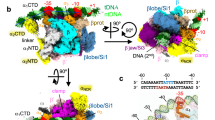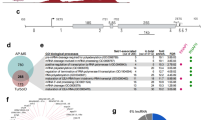Abstract
Ribosomal protein (RP) genes in eukaryotes are coordinately regulated in response to growth stimuli and environmental stress, thereby permitting cells to adjust ribosome number and overall protein synthetic capacity to physiological conditions1,2,3,4,5. Approximately 50% of RNA polymerase II transcription is devoted to RP genes5. The transcriptional regulator Rap1 binds most yeast RP promoters6, and Rap1 sites are important for coordinate regulation of RP genes7,8,9,10. However, Rap1 is not the specific regulator that controls RP transcription because it also functions as a repressor, and many Rap1-activated promoters are not coordinately regulated with RP promoters11,12. Here we show that the transcription factors Fhl1 and Ifh1 associate almost exclusively with RP promoters; association depends on Rap1 and (to a lesser extent) a DNA element at many RP promoters. Ifh1 is recruited to promoters via the forkhead-associated (FHA) domain of Fhl1; the level of Ifh1 associated with RP promoters determines the level of transcription; and environmental stress causes a marked reduction in the association of Ifh1, but not Fhl1 or Rap1. Thus, Ifh1 association with promoters is the key regulatory step for coordinate expression of RP genes.
This is a preview of subscription content, access via your institution
Access options
Subscribe to this journal
Receive 51 print issues and online access
$199.00 per year
only $3.90 per issue
Buy this article
- Purchase on Springer Link
- Instant access to full article PDF
Prices may be subject to local taxes which are calculated during checkout




Similar content being viewed by others
References
Mager, W. H. Control of ribosomal protein gene expression. Biochim. Biophys. Acta 949, 1–15 (1988)
Pogue-Geile, K. et al. Ribosomal protein genes are overexpressed in colorectal cancer: isolation of a cDNA encoding the human S3 ribosomal protein. Mol. Cell. Biol. 11, 3842–3849 (1991)
Seshadri, T., Uzman, J. A., Oshima, J. & Campisi, J. Identification of a transcript that is down-regulated in senescent human fibroblasts. Cloning, sequence analysis, and regulation of the human L7 ribosomal protein gene. J. Biol. Chem. 268, 18474–18480 (1993)
Pierandrei-Amaldi, P. & Amaldi, F. Aspects of regulation of ribosomal protein synthesis in Xenopus laevis. Genetica 94, 181–193 (1994)
Warner, J. R. The economics of ribosome biosynthesis in yeast. Trends Biochem. Sci. 24, 437–440 (1999)
Lieb, J. D., Liu, X. L., Botstein, D. & Brown, P. O. Promoter-specific binding of Rap1 revealed by genome-wide maps of protein-DNA association. Nature Genet. 28, 327–334 (2001)
Moehle, C. M. & Hinnebusch, A. G. Association of RAP1 binding sites with stringent control of ribosomal protein gene transcription in Saccharomyces cerevisiae. Mol. Cell. Biol. 11, 2723–2735 (1991)
Klein, C. & Struhl, K. Protein kinase A mediates growth-regulated expression of yeast ribosomal protein genes by modulating RAP1 transcriptional activity. Mol. Cell. Biol. 14, 1920–1928 (1994)
Li, B., Nierras, C. R. & Warner, J. R. Transcriptional elements involved in the repression of ribosomal protein synthesis. Mol. Cell. Biol. 19, 5393–5404 (1999)
Mencia, M., Moqtaderi, Z., Geisberg, J. V., Kuras, L. & Struhl, K. Activator-specific recruitment of TFIID and regulation of ribosomal protein genes in yeast. Mol. Cell 9, 823–833 (2002)
Shore, D. RAP1: a protean regulator in yeast. Trends Genet. 10, 408–412 (1994)
Morse, R. H. RAP, RAP, open up! New wrinkles for RAP1 in yeast. Trends Genet. 16, 51–53 (2000)
Neuman-Silberberg, F. S., Bhattacharya, S. & Broach, J. R. Nutrient availability and the RAS/cyclic AMP pathway both induce expression of the ribosomal protein genes in Saccharomyces cerevisiae but by different mechanisms. Mol. Cell. Biol. 15, 3187–3196 (1995)
Cardenas, M. E., Cutler, N. S., Lorenz, M. C., Di Como, C. J. & Heitman, J. The TOR signaling cascade regulates gene expression in response to nutrients. Genes Dev. 13, 3271–3279 (1999)
Powers, T. & Walter, P. Regulation of ribosome biogenesis by the rapamycin-sensitive TOR-signaling pathway in Saccharomyces cerevisiae. Mol. Biol. Cell 10, 987–1000 (1999)
Lascaris, R. F., Mager, W. H. & Planta, R. J. DNA-binding requirements of the yeast protein Rap1p as selected in silico from ribosomal protein gene promoter sequences. Bioinformatics 15, 267–277 (1999)
Hermann-Le Denmat, S., Werner, M., Sentenac, A. & Thuriaux, P. Suppression of yeast RNA polymerase III mutations by FHL1, a gene coding for a fork head protein involved in rRNA processing. Mol. Cell. Biol. 14, 2905–2913 (1994)
Lee, T. I. et al. Transcriptional regulatory networks in Saccharomyces cerevisiae. Science 298, 799–804 (2002)
Cherel, I. & Thuriaux, P. The IFH1 gene product interacts with a forkhead protein in Saccharaomyce cerevisiae. Yeast 11, 261–270 (1995)
Goncalves, P. M. et al. Transcription activation of yeast ribosomal protein genes requires additional elements apart from binding sites for Abf1p or Rap1p. Nucleic Acids Res. 23, 1475–1480 (1995)
Beer, M. A. & Tavazoie, S. Predicting gene expression from sequence. Cell 117, 185–198 (2004)
Kim, M., Ahn, J. W., Song, K., Pack, K. H. & Pai, H. S. Forkhead-associated domains of the tobacco NtFHA1 transcription activator and the yeast Fhl1 forkhead transcription factor are functionally conserved. J. Biol. Chem. 277, 38781–38790 (2002)
Brachmann, C. B. et al. Designer deletion strains derived from Saccharomyces cerevisiae S288C: a useful set of strains and plasmids for PCR-mediated gene disruption and other applications. Yeast 14, 115–132 (1993)
Cosma, M. P., Tanaka, T. & Nasmyth, K. Ordered recruitment of transcription and chromatin remodeling factors to a cell cycle- and developmentally regulated promoter. Cell 97, 299–311 (1999)
Gietz, R. D. & Sugino, A. New yeast-Escherichia coli shuttle vectors constructed with in vitro mutagenized yeast genes lacking six-base pair restriction sites. Gene 74, 527–534 (1988)
Aparicio, O. M., Geisberg, J. V. & Struhl, K. in Current Protocols in Molecular Biology (eds Ausubel, F. A. et al.) 21.3.1–21.3.17 (John Wiley & Sons, New York, 2004)
Moqtaderi, Z. & Struhl, K. Genome-wide occupancy of the RNA polymerase III machinery in Saccharomyces cerevisiae reveals loci with incomplete transcription complexes. Mol. Cell. Biol. 24, 4118–4127 (2004)
Roth, F. P., Hughes, J. D., Estep, P. W. & Church, G. M. Finding DNA regulatory motifs within unaligned noncoding sequences clustered by whole-genome mRNA quantitation. Nature Biotechnol. 16, 939–945 (1998)
Crooks, G. E., Hon, G., Chandonia, J. M. & Brenner, S. E. WebLogo: a sequence logo generator. Genome Res. 14, 1188–1190 (2004)
Reid, J. L., Moqtaderi, Z. & Struhl, K. Eaf3 regulates the global pattern of histone acetylation in Saccharomyces cerevisiae. Mol. Cell. Biol. 24, 757–764 (2004)
Acknowledgements
We thank D. Shore for communicating similar results before publication, N. Reppas for help with computational analysis, J. Weiner for assistance with microarrays, and F. Bachand, C. Baisden, and Z. Moqtaderi for technical assistance. We thank J. Geisberg, P. Mason and Z. Moqtaderi for discussions. J.T.W. was supported by a long-term EMBO fellowship, and D.B.H. was supported by a Helen Hay Whitney postdoctoral fellowship. This work was supported by grants to K.S. from the National Institutes of Health.
Author information
Authors and Affiliations
Corresponding author
Ethics declarations
Competing interests
The authors declare that they have no competing financial interests.
Supplementary information
Supplementary Figure 1
Motifs identified from Fhl1 and Ifh1 ChIP-chip analyses. a. Rap1 DNA site as derived from the RP gene promoters identified as Fhl1 targets by ChIP-chip analysis. b. A-rich stretch as derived from the RP gene promoters identified as Fhl1 targets by ChIP-chip analysis. c. Rap1 DNA site as derived from the RP gene promoters identified as Ifh1 targets by ChIP-chip analysis. d. A-rich stretch as derived from the RP gene promoters identified as Ifh1 targets by ChIP-chip analysis. e. IFHL motif as derived from the RP gene promoters identified as Ifh1 targets by ChIP-chip analysis. f. Motif 213 as described previously (Beer and Tavazoie, 2004). (JPG 72 kb)
Supplementary Figure 2
Rap1 occupancy is unaffected by Ifh1 expression. Occupancy of Rap1 0, 30 and 60 min after galactose addition in a strain expressing plasmid-borne copy of IFH1 under the control of the GAL1 promoter. (JPG 37 kb)
Supplementary Figure 3
Effect of heat shock on occupancy of Gal4 fusions. Occupancy of Gal4 DBD, Gal4-FHA and Gal4-Gcr2 at the GAL7 promoter before and after a heat shock. (JPG 31 kb)
Supplementary Table 1
Microarray data for Fhl1 and Ifh1 ChIP-chip. (XLS 1810 kb)
Supplementary Data
MIAME Checklist. (DOC 21 kb)
Rights and permissions
About this article
Cite this article
Wade, J., Hall, D. & Struhl, K. The transcription factor Ifh1 is a key regulator of yeast ribosomal protein genes. Nature 432, 1054–1058 (2004). https://doi.org/10.1038/nature03175
Received:
Accepted:
Issue Date:
DOI: https://doi.org/10.1038/nature03175
This article is cited by
-
Physiological function of FKBP12, a primary target of rapamycin/FK506: a newly identified role in transcription of ribosomal protein genes in yeast
Current Genetics (2021)
-
Integrated TORC1 and PKA signaling control the temporal activation of glucose-induced gene expression in yeast
Nature Communications (2019)
-
Control of RNA polymerase II-transcribed genes by direct binding of TOR kinase
Current Genetics (2018)
-
Mec1ATR is needed for extensive telomere elongation in response to ethanol in yeast
Current Genetics (2018)
-
Sumo and the cellular stress response
Cell Division (2015)
Comments
By submitting a comment you agree to abide by our Terms and Community Guidelines. If you find something abusive or that does not comply with our terms or guidelines please flag it as inappropriate.



